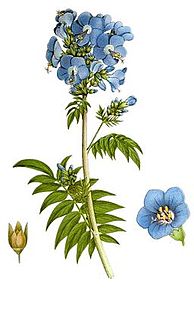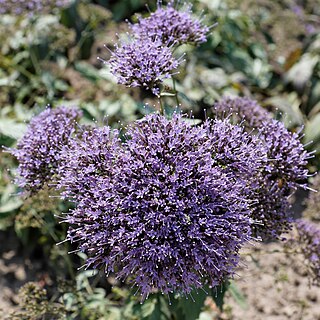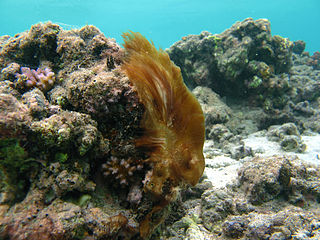
Black band disease is a coral disease in which corals develop a black band. It is characterized by complete tissue degradation due to a pathogenic microbial consortium. The mat is present between apparently healthy coral tissue and freshly exposed coral skeleton.

Polemonium, commonly called Jacob's ladders or Jacob's-ladders, is a genus of between 25 and 40 species of flowering plants in the family Polemoniaceae, native to cool temperate to arctic regions of the Northern Hemisphere. One species also occurs in the southern Andes in South America. Many of the species grow at high altitudes, in mountainous areas. Most of the uncertainty in the number of species relates to those in Eurasia, many of which have been synonymized with Polemonium caeruleum.

The rainbow darter is a small species of freshwater ray-finned fish, a darter from the subfamily Etheostomatinae, part of the family Percidae, which also contains the perches, ruffes and pikeperches. It is native to North America where it is found in small, fast-moving streams and small to medium-sized rivers. It grows to 2 to 3 inches in length. The species is very sensitive to pollution and silt, staying in clean, pollution-free water. The rainbow darter is easily identified by three dark spots on the back, and blue and orange in the dorsal and anal fins.

Polemonium caeruleum, known as Jacob's-ladder or Greek valerian, is a hardy perennial flowering plant. The plant produces cup-shaped, blue or white flowers. It is native to temperate regions of Europe.
British NVC community MG2 is one of the mesotrophic grassland communities in the British National Vegetation Classification system.

Allium caeruleum is an ornamental bulbous plant of the onion genus, native to Central Asia. In these regions, it is found on dry slopes, plains, and steppes.

Zygocarpum caeruleum is a species of flowering plant in the family Fabaceae. It is found only in Yemen. Its natural habitats are subtropical or tropical dry forests and subtropical or tropical dry shrubland.

Exacum is a genus of plant in family Gentianaceae. It contains the following species :
Exacum caeruleum is a species of plant in the Gentianaceae family. It is endemic to Yemen. Its natural habitat is subtropical or tropical dry shrubland.

Cerithium is a genus of small to medium-sized sea snails, marine gastropod molluscs in the family Cerithiidae, the ceriths.

Terana caerulea, commonly known as the cobalt crust fungus or velvet blue spread, is a saprobic crust fungus in the family Phanerochaetaceae. Usually found in warm, damp hardwood forests on the undersides of fallen logs and branches of deciduous trees, this unique fungus has been described as "blue velvet on a stick". This species was chosen as fungus of the year for 2009 by the German Mycological Society.

Cerithium caeruleum, the Cerith sand snail, is a species of sea snail, a marine gastropod mollusk in the family Cerithiidae.

Sedum caeruleum, the sky stone-crop, baby-blue stone-crop or red-leaf, is a species of Sedum from the family Crassulaceae. It is native to northwest Africa, Sardinia, Corsica, and Sicily. The plant is a short, bushy annual with pale blue flowers. The leaves are narrowly oblong and usually tinted red.

Trachelium caeruleum, common name blue throatwort, is a species of flowering plant in the family Campanulaceae native to the Mediterranean, where its native range includes Algeria, Morocco, Portugal, Spain, and Sicily. It has also become naturalized in a few areas, including New Zealand, the Azores, and parts of mainland Europe.

Trachelium is a genus of flowering plants in the family Campanulaceae.

Conospermum caeruleum, commonly known as blue brother, is a shrub in the family Proteaceae and is endemic to the south west of Western Australia. It is a prostrate shrub with small, dense heads of blue, rarely pink flowers and usually grows in heavy soils subject to flooding.

Phormidium is a genus of cyanobacteria in the family Oscillatoriaceae.
Phormidium allorgei is a species of cyanobacteria in the genus Phormidium.
Phormidium ambiguum is a species of cyanobacteria in the genus Phormidium.
Phormidium africanum is a species of cyanobacterium in the genus Phormidium.














